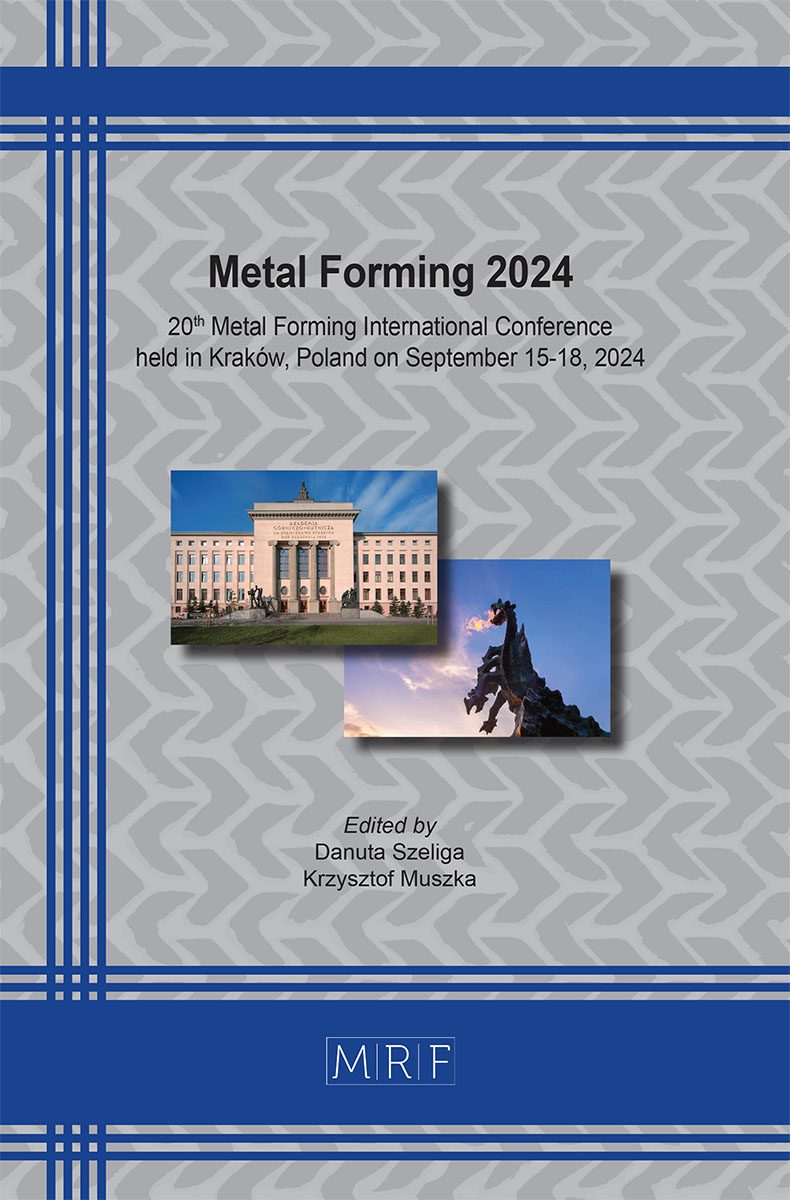–
Research on material deformation in double-sided shearing with preventing enlargement of sheet material on the die using digital image correlation
UEDA Kouki, SASADA Masahiro, TANAKA Tatsuya
download PDFAbstract. In shearing, the effect of preventing the enlargement of sheet material on increasing burnished surface was reported. In this study, double-sided shearing with a suppression plate for preventing the enlargement of sheet material was carried out to investigate the effect of preventing the enlargement of sheet material on the material deformation and crack initiation. During shearing, the material deformation was observed using high speed camera and the distribution of displacement and strain of material were determined from moving images using digital image correlation. The following results were obtained from the observation of the cut surface obtained by shearing and the material deformation during shearing. When the suppression plate prevented the enlargement of the sheet material, the occurrence of cracks in the sheet material around the punch and die cutting edge was delayed. The length of burnished surface increased. For the same reason, the length of burnished surface increased as the trimming allowance of the sheet material was decreased when the enlargement of sheet material was prevented. It was confirmed that preventing the enlargement of sheet material affects the material flow. It is clarified that the equivalent strain around the punch and die cutting edge until crack initiation was increased when the enlargement of sheet material was prevented.
Keywords
Shearing, Digital Image Correlation, Preventing Enlargement, Crack, Strain
Published online 9/15/2024, 9 pages
Copyright © 2024 by the author(s)
Published under license by Materials Research Forum LLC., Millersville PA, USA
Citation: UEDA Kouki, SASADA Masahiro, TANAKA Tatsuya, Research on material deformation in double-sided shearing with preventing enlargement of sheet material on the die using digital image correlation, Materials Research Proceedings, Vol. 44, pp 674-682, 2024
DOI: https://doi.org/10.21741/9781644903254-72
The article was published as article 72 of the book Metal Forming 2024
![]() Content from this work may be used under the terms of the Creative Commons Attribution 3.0 license. Any further distribution of this work must maintain attribution to the author(s) and the title of the work, journal citation and DOI.
Content from this work may be used under the terms of the Creative Commons Attribution 3.0 license. Any further distribution of this work must maintain attribution to the author(s) and the title of the work, journal citation and DOI.
References
[1] K. Kondo, Mechanism of the Shearing Processes of Ductile Sheet Metals (1st Report) -Effect of the Mechanical Properties of Material and Friction of the Tool Surfaces-, J. Japan Soc. Precision Eng. 31 (1965) 476-483.
[2] T. Maeda, T. Nakagawa, Experimental Investigations on Fine Blanking -1st Report-, J. Japan Soc. Tech. Plast. 9 (1968) 618-626.
[3] S. Thippeakmas, M. Jin, M. Murakawa, An investigation of material flow analysis in fine blanking process, J. Mater. Process. Tech. 192 (2007) 237-242. https://dx.doi.org/10.1016/j.jmatprotec.2007.04.065
[4] S. Thipprakmas, Finite element analysis of V-ring indenter mechanism in fine blanking process, Mater. Des. 30 (2009) 526-531. https://doi.org/10.1016/j.matdes.2008.05.072
[5] H. Hoshi, M. Sasada, I. Aoki, Influence of constraint of material on shearing characteristics, Trans. Japan Soc. Mech. Eng. Series C 74 (2008) 206-211. https://dx.doi.org/10.1299/kikaic.74.206
[6] I. Aoki, T. Takahashi, Material flow analysis on shearing process by applying Fourier phase correlation method—analysis of piercing and fine-blanking, J. Mater. Process. Tech. 134 (2003) 45-52.
[7] M. Sasada, T. Togashi, Measurement of rollover in double-sided shearing using image processing and influence of clearance, Procedia Eng. 81 (2014) 1139-1144. https://doi.org/10.1016/j.proeng.2014.10.248
[8] C. Hartmann, H.A. Weiss, P. Lechner, W. Volk, S. Neumayer, J.H. Fitschen, G. Steidl, Measurement of strain, strain rate and crack evolution in shear cutting, J. Mater. Process. Tech. 288 (2021) 116872. https://dx.doi.org/10.1016/j.jmatprotec.2020.116872












